11.7: Understand Slope of a Line (Part 1)
- Page ID
- 5043
\( \newcommand{\vecs}[1]{\overset { \scriptstyle \rightharpoonup} {\mathbf{#1}} } \)
\( \newcommand{\vecd}[1]{\overset{-\!-\!\rightharpoonup}{\vphantom{a}\smash {#1}}} \)
\( \newcommand{\dsum}{\displaystyle\sum\limits} \)
\( \newcommand{\dint}{\displaystyle\int\limits} \)
\( \newcommand{\dlim}{\displaystyle\lim\limits} \)
\( \newcommand{\id}{\mathrm{id}}\) \( \newcommand{\Span}{\mathrm{span}}\)
( \newcommand{\kernel}{\mathrm{null}\,}\) \( \newcommand{\range}{\mathrm{range}\,}\)
\( \newcommand{\RealPart}{\mathrm{Re}}\) \( \newcommand{\ImaginaryPart}{\mathrm{Im}}\)
\( \newcommand{\Argument}{\mathrm{Arg}}\) \( \newcommand{\norm}[1]{\| #1 \|}\)
\( \newcommand{\inner}[2]{\langle #1, #2 \rangle}\)
\( \newcommand{\Span}{\mathrm{span}}\)
\( \newcommand{\id}{\mathrm{id}}\)
\( \newcommand{\Span}{\mathrm{span}}\)
\( \newcommand{\kernel}{\mathrm{null}\,}\)
\( \newcommand{\range}{\mathrm{range}\,}\)
\( \newcommand{\RealPart}{\mathrm{Re}}\)
\( \newcommand{\ImaginaryPart}{\mathrm{Im}}\)
\( \newcommand{\Argument}{\mathrm{Arg}}\)
\( \newcommand{\norm}[1]{\| #1 \|}\)
\( \newcommand{\inner}[2]{\langle #1, #2 \rangle}\)
\( \newcommand{\Span}{\mathrm{span}}\) \( \newcommand{\AA}{\unicode[.8,0]{x212B}}\)
\( \newcommand{\vectorA}[1]{\vec{#1}} % arrow\)
\( \newcommand{\vectorAt}[1]{\vec{\text{#1}}} % arrow\)
\( \newcommand{\vectorB}[1]{\overset { \scriptstyle \rightharpoonup} {\mathbf{#1}} } \)
\( \newcommand{\vectorC}[1]{\textbf{#1}} \)
\( \newcommand{\vectorD}[1]{\overrightarrow{#1}} \)
\( \newcommand{\vectorDt}[1]{\overrightarrow{\text{#1}}} \)
\( \newcommand{\vectE}[1]{\overset{-\!-\!\rightharpoonup}{\vphantom{a}\smash{\mathbf {#1}}}} \)
\( \newcommand{\vecs}[1]{\overset { \scriptstyle \rightharpoonup} {\mathbf{#1}} } \)
\( \newcommand{\vecd}[1]{\overset{-\!-\!\rightharpoonup}{\vphantom{a}\smash {#1}}} \)
\(\newcommand{\avec}{\mathbf a}\) \(\newcommand{\bvec}{\mathbf b}\) \(\newcommand{\cvec}{\mathbf c}\) \(\newcommand{\dvec}{\mathbf d}\) \(\newcommand{\dtil}{\widetilde{\mathbf d}}\) \(\newcommand{\evec}{\mathbf e}\) \(\newcommand{\fvec}{\mathbf f}\) \(\newcommand{\nvec}{\mathbf n}\) \(\newcommand{\pvec}{\mathbf p}\) \(\newcommand{\qvec}{\mathbf q}\) \(\newcommand{\svec}{\mathbf s}\) \(\newcommand{\tvec}{\mathbf t}\) \(\newcommand{\uvec}{\mathbf u}\) \(\newcommand{\vvec}{\mathbf v}\) \(\newcommand{\wvec}{\mathbf w}\) \(\newcommand{\xvec}{\mathbf x}\) \(\newcommand{\yvec}{\mathbf y}\) \(\newcommand{\zvec}{\mathbf z}\) \(\newcommand{\rvec}{\mathbf r}\) \(\newcommand{\mvec}{\mathbf m}\) \(\newcommand{\zerovec}{\mathbf 0}\) \(\newcommand{\onevec}{\mathbf 1}\) \(\newcommand{\real}{\mathbb R}\) \(\newcommand{\twovec}[2]{\left[\begin{array}{r}#1 \\ #2 \end{array}\right]}\) \(\newcommand{\ctwovec}[2]{\left[\begin{array}{c}#1 \\ #2 \end{array}\right]}\) \(\newcommand{\threevec}[3]{\left[\begin{array}{r}#1 \\ #2 \\ #3 \end{array}\right]}\) \(\newcommand{\cthreevec}[3]{\left[\begin{array}{c}#1 \\ #2 \\ #3 \end{array}\right]}\) \(\newcommand{\fourvec}[4]{\left[\begin{array}{r}#1 \\ #2 \\ #3 \\ #4 \end{array}\right]}\) \(\newcommand{\cfourvec}[4]{\left[\begin{array}{c}#1 \\ #2 \\ #3 \\ #4 \end{array}\right]}\) \(\newcommand{\fivevec}[5]{\left[\begin{array}{r}#1 \\ #2 \\ #3 \\ #4 \\ #5 \\ \end{array}\right]}\) \(\newcommand{\cfivevec}[5]{\left[\begin{array}{c}#1 \\ #2 \\ #3 \\ #4 \\ #5 \\ \end{array}\right]}\) \(\newcommand{\mattwo}[4]{\left[\begin{array}{rr}#1 \amp #2 \\ #3 \amp #4 \\ \end{array}\right]}\) \(\newcommand{\laspan}[1]{\text{Span}\{#1\}}\) \(\newcommand{\bcal}{\cal B}\) \(\newcommand{\ccal}{\cal C}\) \(\newcommand{\scal}{\cal S}\) \(\newcommand{\wcal}{\cal W}\) \(\newcommand{\ecal}{\cal E}\) \(\newcommand{\coords}[2]{\left\{#1\right\}_{#2}}\) \(\newcommand{\gray}[1]{\color{gray}{#1}}\) \(\newcommand{\lgray}[1]{\color{lightgray}{#1}}\) \(\newcommand{\rank}{\operatorname{rank}}\) \(\newcommand{\row}{\text{Row}}\) \(\newcommand{\col}{\text{Col}}\) \(\renewcommand{\row}{\text{Row}}\) \(\newcommand{\nul}{\text{Nul}}\) \(\newcommand{\var}{\text{Var}}\) \(\newcommand{\corr}{\text{corr}}\) \(\newcommand{\len}[1]{\left|#1\right|}\) \(\newcommand{\bbar}{\overline{\bvec}}\) \(\newcommand{\bhat}{\widehat{\bvec}}\) \(\newcommand{\bperp}{\bvec^\perp}\) \(\newcommand{\xhat}{\widehat{\xvec}}\) \(\newcommand{\vhat}{\widehat{\vvec}}\) \(\newcommand{\uhat}{\widehat{\uvec}}\) \(\newcommand{\what}{\widehat{\wvec}}\) \(\newcommand{\Sighat}{\widehat{\Sigma}}\) \(\newcommand{\lt}{<}\) \(\newcommand{\gt}{>}\) \(\newcommand{\amp}{&}\) \(\definecolor{fillinmathshade}{gray}{0.9}\)- Use geoboards to model slope
- Find the slope of a line from its graph
- Find the slope of horizontal and vertical lines
- Use the slope formula to find the slope of a line between two points
- Graph a line given a point and the slope
- Solve slope applications
Before you get started, take this readiness quiz.
- Simplify: \(\dfrac{1 − 4}{8 − 2}\). If you missed this problem, review Example 4.6.12.
- Divide: \(\dfrac{0}{4}, \dfrac{4}{0}\). If you missed this problem, review Example 7.5.5.
- Simplify: \(\dfrac{15}{-3}, \dfrac{−15}{3}, \dfrac{−15}{−3}\). If you missed this problem, review Example 4.6.11.
As we’ve been graphing linear equations, we’ve seen that some lines slant up as they go from left to right and some lines slant down. Some lines are very steep and some lines are flatter. What determines whether a line slants up or down, and if its slant is steep or flat?
The steepness of the slant of a line is called the slope of the line. The concept of slope has many applications in the real world. The pitch of a roof and the grade of a highway or wheelchair ramp are just some examples in which you literally see slopes. And when you ride a bicycle, you feel the slope as you pump uphill or coast downhill.
Use Geoboards to Model Slope
In this section, we will explore the concepts of slope.
Using rubber bands on a geoboard gives a concrete way to model lines on a coordinate grid. By stretching a rubber band between two pegs on a geoboard, we can discover how to find the slope of a line. And when you ride a bicycle, you feel the slope as you pump uphill or coast downhill.
We’ll start by stretching a rubber band between two pegs to make a line as shown in Figure \(\PageIndex{1}\).
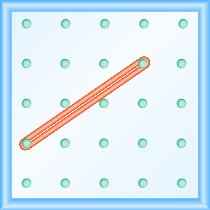
Figure \(\PageIndex{1}\)
Does it look like a line?
Now we stretch one part of the rubber band straight up from the left peg and around a third peg to make the sides of a right triangle as shown in Figure \(\PageIndex{2}\). We carefully make a 90° angle around the third peg, so that one side is vertical and the other is horizontal.

Figure \(\PageIndex{2}\)
To find the slope of the line, we measure the distance along the vertical and horizontal legs of the triangle. The vertical distance is called the rise and the horizontal distance is called the run, as shown in Figure \(\PageIndex{3}\).

Figure \(\PageIndex{3}\)
To help remember the terms, it may help to think of the images shown in Figure \(\PageIndex{4}\).
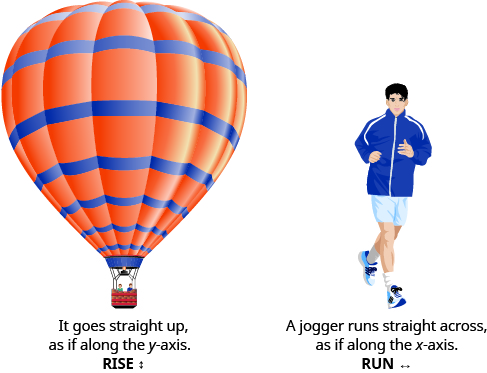
Figure \(\PageIndex{4}\)
On our geoboard, the rise is 2 units because the rubber band goes up 2 spaces on the vertical leg. See Figure \(\PageIndex{5}\).
What is the run? Be sure to count the spaces between the pegs rather than the pegs themselves! The rubber band goes across 3 spaces on the horizontal leg, so the run is 3 units.
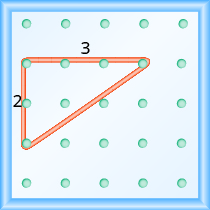
Figure \(\PageIndex{5}\)
The slope of a line is the ratio of the rise to the run. So the slope of our line is \(\dfrac{2}{3}\). In mathematics, the slope is always represented by the letter m.
The slope of a line is m = \(\dfrac{rise}{run}\).
The rise measures the vertical change and the run measures the horizontal change.
What is the slope of the line on the geoboard in Figure \(\PageIndex{5}\)?
\[\begin{split} m &= \dfrac{rise}{run} \\ m &= \dfrac{2}{3} \\ The\; line\; &has\; slope\; \dfrac{2}{3} \ldotp \end{split}\]
When we work with geoboards, it is a good idea to get in the habit of starting at a peg on the left and connecting to a peg to the right. Then we stretch the rubber band to form a right triangle.
If we start by going up the rise is positive, and if we stretch it down the rise is negative. We will count the run from left to right, just like you read this paragraph, so the run will be positive.
Since the slope formula has rise over run, it may be easier to always count out the rise first and then the run.
What is the slope of the line on the geoboard shown?
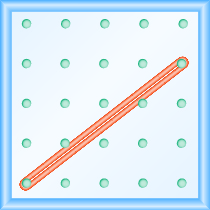
Solution
Use the definition of slope.
\[m = \dfrac{rise}{run}\]
Start at the left peg and make a right triangle by stretching the rubber band up and to the right to reach the second peg. Count the rise and the run as shown.
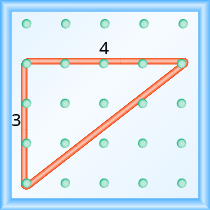
The rise is 3 units. \[m = \dfrac{3}{run}\]
The run is 4 units. \[m = \dfrac{3}{4}\]
The slope is \(\dfrac{3}{4}\).
What is the slope of the line on the geoboard shown?
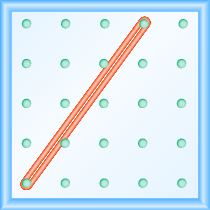
- Answer
-
\(\frac{4}{3}\)
What is the slope of the line on the geoboard shown?
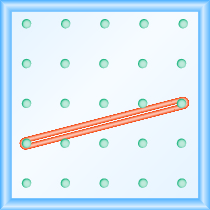
- Answer
-
\(\frac{1}{4}\)
What is the slope of the line on the geoboard shown?
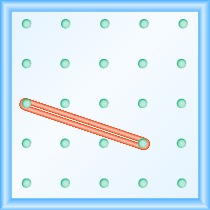
Solution
Use the definition of slope.
\[m = \dfrac{rise}{run}\]
Start at the left peg and make a right triangle by stretching the rubber band to the peg on the right. This time we need to stretch the rubber band down to make the vertical leg, so the rise is negative.
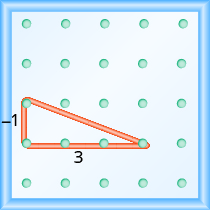
The rise is −1.
\[m = \dfrac{−1}{run}\]
The run is 3.
\[\begin{split} m &= \dfrac{−1}{3} \\ m &= − \dfrac{1}{3} \end{split}\]
The slope is \(− \dfrac{1}{3}\).
What is the slope of the line on the geoboard?
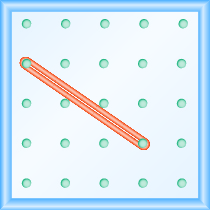
- Answer
-
\(-\frac{2}{3}\)
What is the slope of the line on the geoboard?
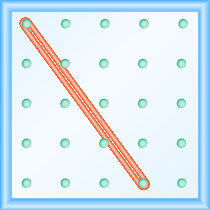
- Answer
-
\(-\frac{4}{3}\)
Notice that in the first example, the slope is positive and in the second example the slope is negative. Do you notice any difference in the two lines shown in Figure \(\PageIndex{6}\).
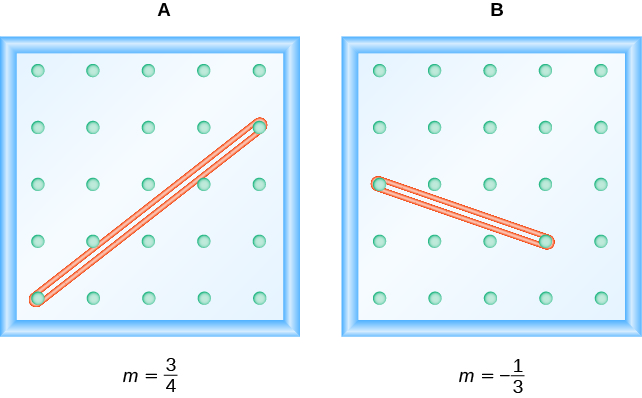
Figure \(\PageIndex{6}\)
As you read from left to right, the line in Figure A, is going up; it has positive slope. The line Figure B is going down; it has negative slope.

Figure \(\PageIndex{7}\)
Use a geoboard to model a line with slope \(\frac{1}{2}\).
Solution
To model a line with a specific slope on a geoboard, we need to know the rise and the run.
| Use the slope formula. | $$m = \dfrac{rise}{run}$$ |
| Replace m with \(\dfrac{1}{2}\). | $$\dfrac{1}{2} = \dfrac{rise}{run}$$ |
So, the rise is 1 unit and the run is 2 units.
Start at a peg in the lower left of the geoboard. Stretch the rubber band up 1 unit, and then right 2 units.
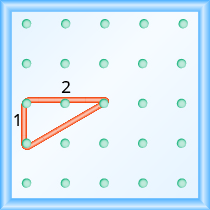
The hypotenuse of the right triangle formed by the rubber band represents a line with a slope of \(\dfrac{1}{2}\).
Use a geoboard to model a line with the given slope: m = \(\dfrac{1}{3}\).
- Answer
-
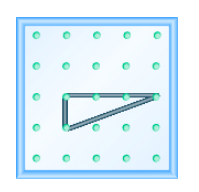
Use a geoboard to model a line with the given slope: m = \(\dfrac{3}{2}\).
- Answer
-
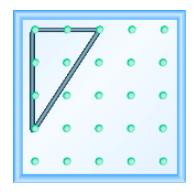
Use a geoboard to model a line with slope \(\dfrac{−1}{4}\).
Solution
| Use the slope formula. | $$m = \dfrac{rise}{run}$$ |
| Replace m with \(− \dfrac{1}{4}\). | $$- \dfrac{1}{4} = \dfrac{rise}{run}$$ |
So, the rise is −1 and the run is 4.
Since the rise is negative, we choose a starting peg on the upper left that will give us room to count down. We stretch the rubber band down 1 unit, then to the right 4 units.
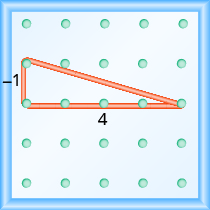
The hypotenuse of the right triangle formed by the rubber band represents a line whose slope is \(− \dfrac{1}{4}\).
Use a geoboard to model a line with the given slope: m = \(\dfrac{−3}{2}\).
- Answer
-
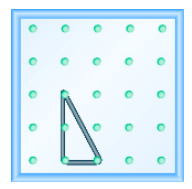
Use a geoboard to model a line with the given slope: m = \(\dfrac{−1}{3}\).
- Answer
-
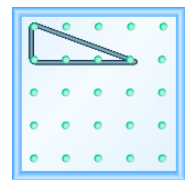
Find the Slope of a Line from its Graph
Now we’ll look at some graphs on a coordinate grid to find their slopes. The method will be very similar to what we just modeled on our geoboards.
To find the slope, we must count out the rise and the run. But where do we start?
We locate any two points on the line. We try to choose points with coordinates that are integers to make our calculations easier. We then start with the point on the left and sketch a right triangle, so we can count the rise and run.
Find the slope of the line shown:
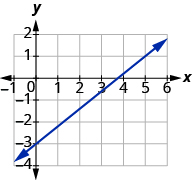
Solution
Locate two points on the graph, choosing points whose coordinates are integers. We will use (0, −3) and (5, 1).
Starting with the point on the left, (0, −3), sketch a right triangle, going from the first point to the second point, (5, 1).

| Count the rise on the vertical leg of the triangle. | The rise is 4 units. |
| Count the run on the horizontal leg. | The run is 5 units. |
| Use the slope formula. | $$m = \dfrac{rise}{run}$$ |
| Substitute the values of the rise and run. | $$m = \dfrac{4}{5}$$ |
The slope of the line is \(\dfrac{4}{5}\).
Notice that the slope is positive since the line slants upward from left to right.
Find the slope of the line:
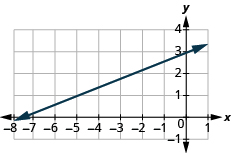
- Answer
-
\(\frac{2}{5}\)
Find the slope of the line:
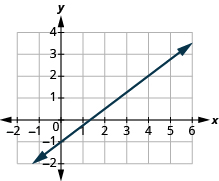
- Answer
-
\(\frac{3}{4}\)
Step 1. Locate two points on the line whose coordinates are integers.
Step 2. Starting with the point on the left, sketch a right triangle, going from the first point to the second point.
Step 3. Count the rise and the run on the legs of the triangle.
Step 4. Take the ratio of rise to run to find the slope.
\[m = \dfrac{rise}{run}\]
Find the slope of the line shown:
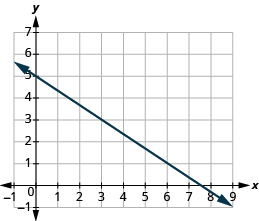
Solution
Locate two points on the graph. Look for points with coordinates that are integers. We can choose any points, but we will use (0, 5) and (3, 3). Starting with the point on the left, sketch a right triangle, going from the first point to the second point.
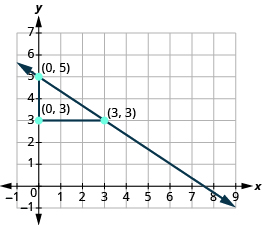
| Count the rise – it is negative. | The rise is −2. |
| Count the run. | The run is 3. |
| Use the slope formula. | $$m = \dfrac{rise}{run}$$ |
| Substitute the values of the rise and run. | $$m = \dfrac{-2}{3}$$ |
| Simplify. | $$m = - \dfrac{2}{3}$$ |
The slope of the line is \(− \dfrac{2}{3}\).
Notice that the slope is negative since the line slants downward from left to right.
What if we had chosen different points? Let’s find the slope of the line again, this time using different points. We will use the points (−3, 7) and (6, 1).
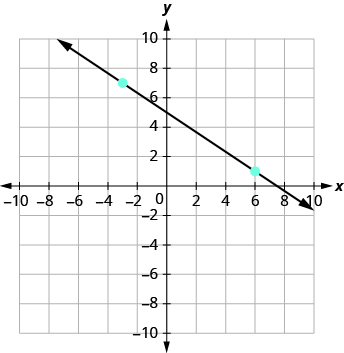
Starting at (−3, 7), sketch a right triangle to (6, 1).
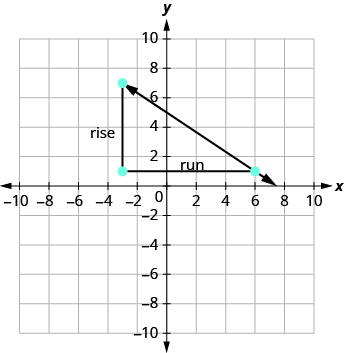
| Count the rise. | The rise is −6. |
| Count the run. | The run is 9. |
| Use the slope formula. | $$m = \dfrac{rise}{run}$$ |
| Substitute the values of the rise and run. | $$m = \dfrac{-6}{9}$$ |
| Simplify the fraction. | $$m = - \dfrac{2}{3}$$ |
The slope of the line is \(− \dfrac{2}{3}\).
It does not matter which points you use—the slope of the line is always the same. The slope of a line is constant!
Find the slope of the line:
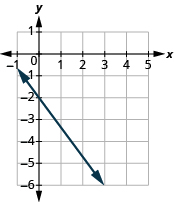
- Answer
-
\(-\frac{4}{3}\)
Find the slope of the line:

- Answer
-
\(-\frac{3}{5}\)
The lines in the previous examples had y-intercepts with integer values, so it was convenient to use the y-intercept as one of the points we used to find the slope. In the next example, the y-intercept is a fraction. The calculations are easier if we use two points with integer coordinates.
Find the slope of the line shown:
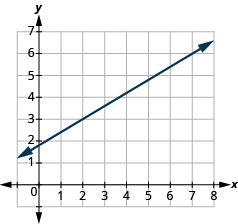
Solution
| Locate two points on the graph whose coordinates are integers. | (2, 3) and (7, 6) |
| Which point is on the left? | (2, 3) |
Starting at (2, 3), sketch a right angle to (7, 6) as shown below.
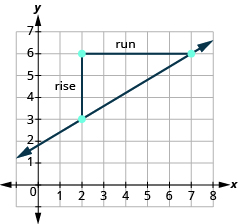
| Count the rise. | The rise is 3. |
| Count the run. | The run is 5. |
| Use the slope formula. | $$m = \dfrac{rise}{run}$$ |
| Substitute the values of the rise and run. | $$m = \dfrac{3}{5}$$ |
The slope of the line is \(\dfrac{3}{5}\).
Find the slope of the line:
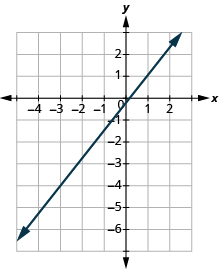
- Answer
-
\(\frac{5}{4}\)
Find the slope of the line:
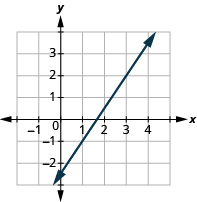
- Answer
-
\(\frac{3}{2}\)
Find the Slope of Horizontal and Vertical Lines
Do you remember what was special about horizontal and vertical lines? Their equations had just one variable.
- horizontal line y = b; all the y -coordinates are the same.
- vertical line x = a; all the x -coordinates are the same.
So how do we find the slope of the horizontal line y = 4? One approach would be to graph the horizontal line, find two points on it, and count the rise and the run. Let’s see what happens in Figure \(\PageIndex{8}\). We’ll use the two points (0, 4) and (3, 4) to count the rise and run.
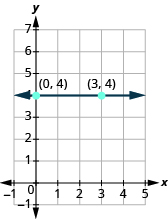
Figure \(\PageIndex{8}\)
| What is the rise? | The rise is 0. |
| What is the run? | The run is 3. |
| What is the slope? | $$m = \dfrac{rise}{run} \tag{11.4.21}$$ |
| $$m = \dfrac{0}{3} \tag{11.4.22}$$ | |
| $$m = 0 \tag{11.4.23}$$ |
The slope of the horizontal line y = 4 is 0.
All horizontal lines have slope 0. When the y-coordinates are the same, the rise is 0.
The slope of a horizontal line, y = b, is 0.
Now we’ll consider a vertical line, such as the line x = 3, shown in Figure \(\PageIndex{9}\). We’ll use the two points (3, 0) and (3, 2) to count the rise and run.
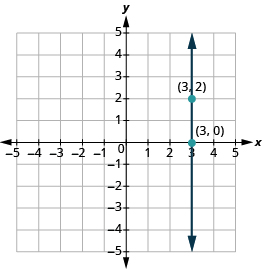
Figure \(\PageIndex{9}\)
| What is the rise? | The rise is 2. |
| What is the run? | The run is 0. |
| What is the slope? | $$m = \dfrac{rise}{run} \tag{11.4.24}$$ |
| $$m = \dfrac{2}{0} \tag{11.4.25}$$ |
But we can’t divide by 0. Division by 0 is undefined. So we say that the slope of the vertical line x = 3 is undefined. The slope of all vertical lines is undefined, because the run is 0.
The slope of a vertical line, x = a, is undefined.
Find the slope of each line: (a) x = 8 (b) y = −5
Solution
(a) x = 8
This is a vertical line, so its slope is undefined.
(b) y = −5
This is a horizontal line, so its slope is 0.
Find the slope of the line: x = −4.
- Answer
-
undefined
Find the slope of the line: y = 7.
- Answer
-
0

Use the Slope Formula to find the Slope of a Line between Two Points
Sometimes we need to find the slope of a line between two points and we might not have a graph to count out the rise and the run. We could plot the points on grid paper, then count out the rise and the run, but there is a way to find the slope without graphing.
Before we get to it, we need to introduce some new algebraic notation. We have seen that an ordered pair (x, y) gives the coordinates of a point. But when we work with slopes, we use two points. How can the same symbol (x, y) be used to represent two different points?
Mathematicians use subscripts to distinguish between the points. A subscript is a small number written to the right of, and a little lower than, a variable.
- (x1, y1) read x sub 1, y sub 1
- (x2, y2) read x sub 2, y sub 2
We will use (x1, y1) to identify the first point and (x2, y2) to identify the second point. If we had more than two points, we could use (x3, y3), (x4, y4), and so on.
To see how the rise and run relate to the coordinates of the two points, let’s take another look at the slope of the line between the points (2, 3) and (7, 6) in Figure \(\PageIndex{10}\).
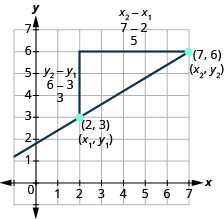
Figure \(\PageIndex{10}\)
Since we have two points, we will use subscript notation.
\[\begin{split} x_{1}, y_{1} \qquad &x_{2}, y_{2} \\ (2, 3) \qquad &(7, 6) \end{split}\]
On the graph, we counted the rise of 3. The rise can also be found by subtracting the y-coordinates of the points.
\[\begin{split} y_{2} &- y_{1} \\ 6 &- 3 \\ &\; 3 \end{split}\]
We counted a run of 5. The run can also be found by subtracting the x-coordinates.
\[\begin{split} x_{2} &- x_{1} \\ 7 &- 2 \\ &\; 5 \end{split}\]
| We know | $$m = \dfrac{rise}{run} \tag{11.4.26}$$ |
| So | $$m = \dfrac{3}{5} \tag{11.4.27}$$ |
| We rewrite the rise and run by putting in the coordinates. | $$m = \dfrac{6 - 3}{7 - 2} \tag{11.4.28}$$ |
| But 6 is the y-coordinate of the second point, y2 and 3 is the y-coordinate of the first point y1. So we can rewrite the rise using subscript notation. | $$m = \dfrac{y_{2} - y_{1}}{7 - 2} \tag{11.4.29}$$ |
| Also 7 is the x-coordinate of the second point, x2 and 2 is the x-coordinate of the first point x2. So we rewrite the run using subscript notation. | $$m = \dfrac{y_{2} - y_{1}}{x_{2} - x_{1}} \tag{11.4.30}$$ |
We’ve shown that m = \(\dfrac{y_{2} − y_{1}}{x_{2} − x_{1}}\) is really another version of m = \(\dfrac{rise}{run}\). We can use this formula to find the slope of a line when we have two points on the line.
The slope of the line between two points (x1, y1) and (x2, y2) is
\[m = \dfrac{y_{2} - y_{1}}{x_{2} - x_{1}} \tag{11.4.31}\]
Say the formula to yourself to help you remember it:
Slope is y of the second point minus y of the first point
over
x of the second point minus x of the first point.
Find the slope of the line between the points (1, 2) and (4, 5).
Solution
| We’ll call (1, 2) point #1 and (4, 5) point #2. | $$\begin{split} x_{1}, y_{1} \qquad &x_{2}, y_{2} \\ (1, 2) \qquad &(4, 5) \end{split}$$ |
| Use the slope formula. | $$m = \dfrac{y_{2} - y_{1}}{x_{2} - x_{1}} \tag{11.4.32}$$ |
| Substitute the values in the slope formula: | |
| y of the second point minus y of the first point | $$m = \dfrac{5 - 2}{x_{2} - x_{1}} \tag{11.4.33}$$ |
| x of the second point minus x of the first point | $$m = \dfrac{5 - 2}{4 - 1} \tag{11.4.34}$$ |
| Simplify the numerator and the denominator. | $$m = \dfrac{3}{3} \tag{11.4.35}$$ |
| m = 1 |
Let’s confirm this by counting out the slope on the graph.
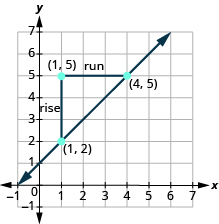
The rise is 3 and the run is 3, so
\[\begin{split} m &= \dfrac{rise}{run} \\ m &= \dfrac{3}{3} \\ m &= 1 \end{split}\]
Find the slope of the line through the given points: (8, 5) and (6, 3).
- Answer
-
1
Find the slope of the line through the given points: (1, 5) and (5, 9).
- Answer
-
1
How do we know which point to call #1 and which to call #2? Let’s find the slope again, this time switching the names of the points to see what happens. Since we will now be counting the run from right to left, it will be negative.
| We’ll call (4, 5) point #1 and (1, 2) point #2. | $$\begin{split} x_{1}, y_{1} \qquad &x_{2}, y_{2} \\ (4, 5) \qquad &(1, 2) \end{split}$$ |
| Use the slope formula. | $$m = \dfrac{y_{2} - y_{1}}{x_{2} - x_{1}} \tag{11.4.36}$$ |
| Substitute the values in the slope formula: | |
| y of the second point minus y of the first point | $$m = \dfrac{2 - 5}{x_{2} - x_{1}} \tag{11.4.37}$$ |
| x of the second point minus x of the first point | $$m = \dfrac{2 - 5}{1 - 4} \tag{11.4.38}$$ |
| Simplify the numerator and the denominator. | $$m = \dfrac{-3}{-3} \tag{11.4.39}$$ |
| m = 1 |
The slope is the same no matter which order we use the points.
Find the slope of the line through the points (−2, −3) and (−7, 4).
Solution
| We’ll call (−2, −3) point #1 and (−7, 4) point #2. | $$\begin{split} x_{1}, y_{1} \qquad &x_{2}, y_{2} \\ (-2, -3) \qquad &(-7, 4) \end{split}$$ |
| Use the slope formula. | $$m = \dfrac{y_{2} - y_{1}}{x_{2} - x_{1}} \tag{11.4.40}$$ |
| Substitute the values. | |
| y of the second point minus y of the first point | $$m = \dfrac{4 - (-3)}{x_{2} - x_{1}} \tag{11.4.41}$$ |
| x of the second point minus x of the first point | $$m = \dfrac{4 - (-3)}{-7 - (-2)} \tag{11.4.42}$$ |
| Simplify. | $$m = \dfrac{7}{-5} \tag{11.4.43}$$ |
| m = \(- \dfrac{7}{5}\) |
Let’s confirm this on the graph shown.
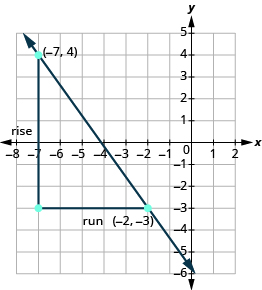
\[\begin{split} m &= \dfrac{rise}{run} \\ m &= \dfrac{-7}{5} \\ m &= - \dfrac{7}{5} \end{split}\]
Find the slope of the line through the pair of points: (−3, 4) and (2, −1).
- Answer
-
-1
Find the slope of the line through the pair of points: (−2, 6) and (−3, −4).
- Answer
-
10
Contributors and Attributions
Lynn Marecek (Santa Ana College) and MaryAnne Anthony-Smith (Formerly of Santa Ana College). This content is licensed under Creative Commons Attribution License v4.0 "Download for free at http://cnx.org/contents/fd53eae1-fa2...49835c3c@5.191."


